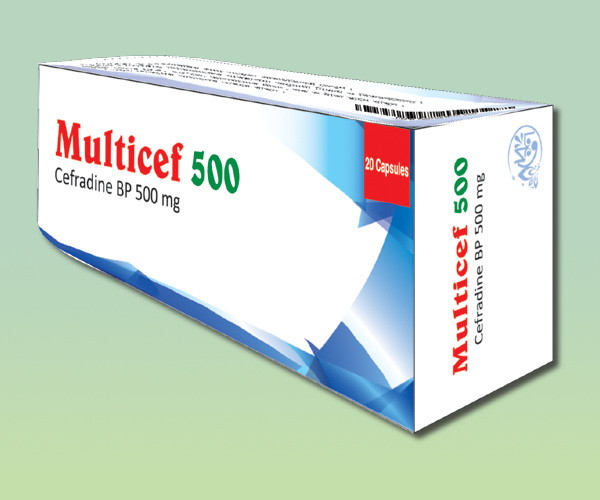Multicef 500
Cefradine BP 500mg
Multicef 500
Cefradine BP 500mg
Cephradine is demonstrated for the treatment of contaminations caused by delicate Gram-positive and Gram-negative microbes. These include- Undesirable Upper respiratory tract diseases: sinusitis, pharyngitis, tonsillitis, laryngo-tracheo bronchitis and otitis media, and also Lower respiratory tract diseases: bronchitis (intense and incessant), lobar pneumonia and bronchopneumonia. Urinary tract diseases: cystitis, urethritis and pyelonephritis. Skin and delicate tissue diseases: boil, cellulitis, furunculosis and impetigo. The taking after microorganisms are helpless, in vitro to Cephradine: Gram-positive: Staphylococci (both penicillin delicate and safe strains and penicillinase-producing species), Streptococci, Streptococci pyogenes (beta haemolytic), Streptococcus pneumonia. Gram-negative: Escherichia coli, Klebsiella spp, Proteus mirabilis, Haemophilus flu, Shigella spp, Salmonella spp (counting Salmonella typhi), Neisseria spp Numerous strains of E.coli.
- AVAILABILITY: AVAILABLE
Indications of Multicef 500
Cephradine is demonstrated for the treatment of contaminations caused by delicate Gram-positive and Gram-negative microbes. These include- Undesirable Upper respiratory tract diseases: sinusitis, pharyngitis, tonsillitis, laryngo-tracheo bronchitis and otitis media, and also Lower respiratory tract diseases: bronchitis (intense and incessant), lobar pneumonia and bronchopneumonia. Urinary tract diseases: cystitis, urethritis and pyelonephritis. Skin and delicate tissue diseases: boil, cellulitis, furunculosis and impetigo. The taking after microorganisms are helpless, in vitro to Cephradine: Gram-positive: Staphylococci (both penicillin delicate and safe strains and penicillinase-producing species), Streptococci, Streptococci pyogenes (beta haemolytic), Streptococcus pneumonia. Gram-negative: Escherichia coli, Klebsiella spp, Proteus mirabilis, Haemophilus flu, Shigella spp, Salmonella spp (counting Salmonella typhi), Neisseria spp Numerous strains of E.coli.
Pharmacology
Cephradine may be a semisynthetic wide range bactericidal anti-microbial, it is dynamic against diseases caused by both gram-positive and gram-negative microorganisms. Both penicillinase creating and nonproducing staphylococci are touchy to Cephradine. The most location of activity of Cephradine is the cell divider of microbes. Cell divider of touchy life form contains peptidoglycan. Cephradine represses cross-linking prepare and as a result cell divider with numerous pores are shaped, hence lysis of microbes happen due to outside osmotic weight.
Dosage & Administration
For oral administration-
Adults:
- Urinary tract infections: 500mg four times daily or 1g twice daily. Infections which are severe or chronic may necessitate the administration of higher doses. Where complications arise including prostatitis and epididymitis continued intensive treatment is required.
- Respiratory tract infections: 250 to 500mg four times daily or 500mg to 1g twice daily, dependent on the site and severity of the infection.
- Skin and soft tissue infections: 250 to 500mg four times daily or 500mg to 1g twice daily, again dependent on the site and severity of the infection.
Children:
- Total daily dose of 25 to 50mg/kg given in two or four equally divided doses.
- Otitis media: Total daily dose of 75 to 100mg/kg given in divided doses 6 to 12 hourly.
- Maximum daily dosage: 4 gm
Elderly: The normal adult dose is appropriate. Patients with impaired renal or hepatic function should be monitored during treatment.
For injectable administration-
- Adult: The usual dose is 2-4 gm daily in four equally divided doses up to 8 gm daily. For prophylaxis a single preoperative dose of 1-2 gm intramuscularly or intravenously is given.
- Children: The dose is 50-100 mg/kg daily in four equally divided doses, up to 300 mg/kg daily in severe infection.
Interaction of Multicef 500
The concomitant utilize of nephrotoxic drugs such as aminoglycosides with Cefradine may increment the hazard of kidney harm. Diuretics (e.g. frusemide, ethacrynic corrosive) and probenecid improved the plausibility of renal poisonous quality.
Contraindications
Cephradine should not be used in patients with known or suspected hypersensitivity to cephalosporins.
Side Effects of Multicef 500
Blood and lymphatic framework disarranges- Obscure: blood disarranges (counting thrombocytopenia, leucopenia, agranulocytosis, aplastic frailty and haemolytic anaemia) Immune framework disarranges- Obscure: Fever, serum affliction like responses, anaphylaxis Psychiatric disarranges- Obscure: Perplexity, rest disturbances Nervous framework disarranges- Obscure: hyperactivity, hypertonia, tipsiness, anxiety; Seldom: Headache Hepatobiliary disarranges- Recurrence obscure: Liver, chemical unsettling influences, temporal hepatitis, cholestatic jaundice Renal and urinary clutters- Obscure: Reversible interstitial nephritis Investigations- Obscure: Height of blood urea nitrogen, serum creatinine, alanine aminotransferase, aspartate aminotransferase, add up to bilirubin, antacid phosphatase.
Pregnancy & Lactation
In spite of the fact that creature ponders have not illustrated any teratogenicity, security in pregnancy has not been set up. Cephradine is excreted in breast drain and ought to be utilized with caution in lactating moms. Since the medication may cause tipsiness, patients ought to be cautioned almost working unsafe apparatus, counting automobiles.
Precautions & Warnings
Delayed utilize of an anti-infective may result within the advancement of superinfection due to the rise of safe organisms. Cephradine ought to be managed with care to patients extremely touchy to penicillins since of the hazard of cross-sensitivity between beta-lactam antibiotics. Cephalosporin anti-microbials may cause a positive result in Coombs’ testing. When Coombs testing is performed on neonates whose moms gotten cephalosporins earlier to work, it ought to be famous that a positive result may be due to the drug. Cephradine may cause a untrue positive pee glucose result when Benedict’s or Fehling’s arrangements or tablets such as Clinitest are utilized within the testing. This does not happen with enzyme-based tests (e.g. Clinistix, Diastix). Dosage alteration is fundamental in renal impairment. This item contains lactose. Patients with uncommon innate issues of galactose narrow mindedness, the Lapp lactase lack or glucose-galactose malabsorption ought to not take this medication.
Therapeutic Class
First generation Cephalosporins
Storage Conditions
Protect from light and moisture by storing below 30°C. Keep the medicine out of children's reach.
